Couldn’t resist planting these Kalanchoe daigremontiana and a few Kalanchoe tormentosa and other cacti and succulents in tiny pots as we get ready for the September meeting of the Miniature Settings artists for the 2014 Flower Show. I want to show everyone how one plant (the Kalanchoe daigremontiana) can be made to look like many different plants depending how you grow it.
Tag: Kalanchoe daigremontiana
Magical Plants with Muggle Thumbs, Part 1
The challenge today is how to represent the magical plants from Harry Potter that will be part of Sprout’s Greenhouse for this year’s Flower Show entry.
First I started with a list of the magical plants that appear in the books, movies, games, and websites. The list and an explanation of the plants can be found in several places including at the Harry Potter Lexicon and the Harry Potter wiki, and a few muggle-world equivalents can be found at Dave’s Garden and Idiot’s Guide.
The challenge becomes finding real-world equivalents, in miniature, to the Harry Potter magical plants. Remember our rules are that we have to use all real plant materials (so I can’t, for example, design a Venomous Tentacula vine out of string or clay).
So far, I have chosen the following plants to include: Mandrake, Rue, Gillyweed, Wolfsbane, Dittany, Devil’s Snare, Fanged Geranium, Bubotuber, Abyssinian Shrivelfig, Bouncing Bulb, Chinese Chomping Cabbage, Flitterbloom, Flutterby Bush, Gurdyroot, Honking Daffodil, Leaping Toadstool, Mimbulus Mimbletonia, Screechsnap, Venomous Tentacula.
MANDRAKE:
Mandrake is one of the plants that has many images in the HP universe. This makes matching it for the miniature setting harder because of the expectations of the audience who are familiar with these images. These are scenes of the repotting of the mandrakes in Greenhouse 3 in Harry’s second year.
This is an image of the repotting from the Pottermore site, a fan site developed by J.K. Rowling.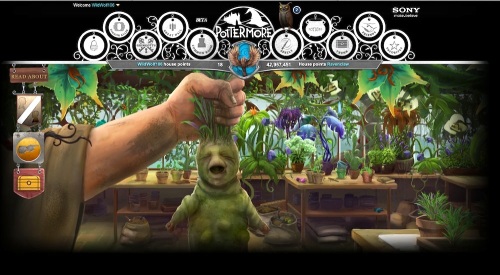
I am still working on whether to make the Mandrake root with clay or with 3D printing but for now the question is what plant to use to represent the foliage. The Mandrakes will be planted in both pots and on bedding benches so I need a lot of them. One choice is Blood Sorrel (Rumex) which I have been growing easily from seed. The veins are red rather than white (like in the movie) but in real life the plants to not have prominent veins.
The real Mandrake, which I am also growing, has no coloring in its veins:
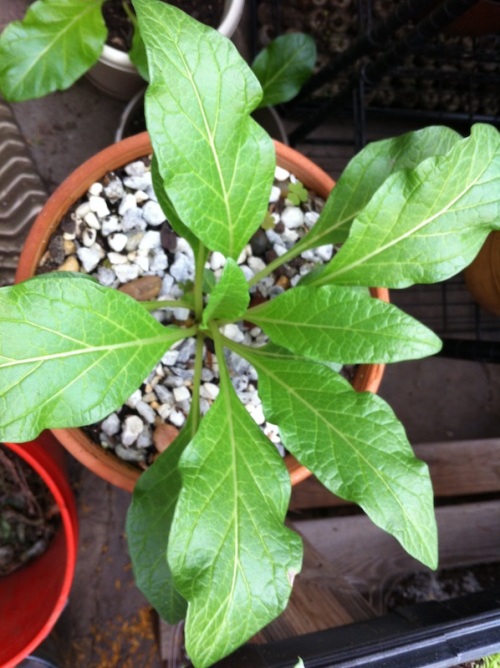
Another possibility is the Kalanchoe daigremontiana known as Mother-of-Thousands because of the little baby plantlets it drops. If I can keep the size of these down, they could work:
They will stay alive in both the beds and on top of the heads of the marauding roots I am designing and I have plenty of them. Other possibilities include Hypoestes Phylostachya (the white version of the pink polka dot plant)
or Fittonia albivens (rather than this pink one):
I am favoring the Kalanchoe at the moment.
RUE:
Rue is a real plant (Ruta graveolens) that has long been grown as an herb and as a medicinal plant. In Harry Potter it is mentioned as an antidote for poison when, in the Half-Blood Prince (book 6), Ron drinks poisoned mead and is given a rue mixture by Madame Pomfrey. I will use actual rue plant, taken from small cuttings, to stand in for the magical rue. Even though a plant with smaller leaves would be more accurate (this is a 2 inch pot) I think the unique bluish coloring of rue limits what plants can be used.

GILLYWEED:
Gillyweed was explained in a previous blog but to summarize, it is a water plant that Harry uses to be able to breathe underwater for one hour in the Triwizard tournament. We don’t see the full plant in the movies or books but we do see the slimy parts that Harry has to swallow:

The movie suggests that Neville reads about it in a book Mad Eye Moody lends him in the movie: Magical Water Plants of the Highland Lochs. In the book, gillyweed is said to be mentioned in a similar book, Magical Water Plants of the Mediterranean, but Harry does not manage to get that information from the book (Dobby gives it to him). Here is a replica of the Highland Lochs book designed by Betsy Coe for her Diagon Alley event in 2009:
It is likely that I will use Bacopa caroliniana to stand in for gillyweed because it is growing nicely in one of my tanks and has nice long stems like the ones Harry is holding.
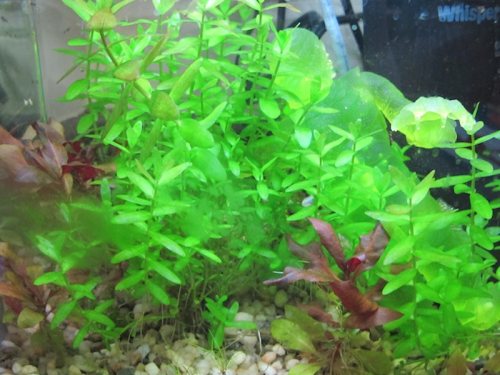
WOLFSBANE:
Wolfsbane (often mistakenly named wolfbane) is a real plant (Aconitum, also called monkshood) that has been used in many cultures as a poison and as an ingredient in herbal medications. In Harry Potter, wolfsbane is an ingredient in the potion that Severus Snape mixes up to give Remus Lupin (in Prisoner of Azkaban, book 3) so that his transformation into a werewolf is more controlled.
In the 1941 movie, The Wolf Man, starring Lon Chaney, Jr., wolfsbane is picked by one of the werewolf’s victims. Since most of the plant, including the flowers, are toxic to the touch, this is an unlikely scenario. Still, it connects the plant to the werewolf myth which was mostly developed in this early horror film.

You can see the clip of Jennie picking the wolfsbane (she calls it wolfbane) at this link:
Wolfsbane in The Wolf Man (1941)
This poem is recited throughout the film:
Even a man who is pure in heart
And says his prayers by night
Will become a wolf
When the wolfbane blooms
And the autumn moon is bright.
The plant I will use for wolfsbane needs to have the palmate leaves of the real plant:

One possibility is is Hedera helix ‘itsy bitsy.’ It does have a great leaf shape and is an erect plant, but I only have one.
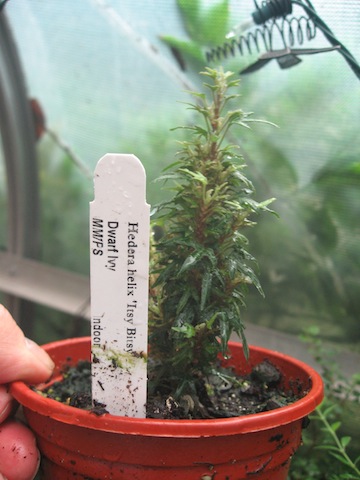
Perhaps sweet woodruff (Galium odoratum) is a possibility and I have just brought a few clipping into the greenhouse to see if they stay alive.

That is the end of Part 1. More to come.
Miniature Plant Propagation Techniques
Plant Propagation Techniques
There is nothing more amazing that putting plant material in a growing medium and having tiny baby pants develop. For miniature gardens, these homegrown mini-plants are essential if you want to control the size of your plants and also the number of them. When I want to propagate a lot of material, I take cuttings from inexpensive plants I buy in garden centers, hardware stores, and grocery stores. I also use plants growing in my yard and in my neighborhood.
When I need a mature, high quality plant, I buy it from Meehan’s Miniatures, Meadowbrook Farm, or online miniature plant sources, especially Two Green Thumbs (owner Janit Calvo writes a great miniature gardening newsletter). Keep in mind that some plants you buy from professional growers may have propagation restrictions and you may not be able to use them as source material. Also, the miniature plant growers mentioned here and in other posts on this blog provide high quality, rooted and healthy plants that should last a long time. Your homegrown ones may be as strong or not last as long.
Propagating plants for a miniature display requires an eye for proportions as well as good timing so the plants are the correct size when they are needed. Here are some guidelines for your own miniature plant propagation. Remember that for the Philadelphia Flower Show, the miniature plants used must be rooted (if they are on the list of plants submitted to fulfill the 8-plant requirement). The times for each propagation technique indicate a rooted and growing plant.
Seeds (3-12 weeks)
Plant seeds in a growing medium and keep damp. Bottom heat can help some seeds germinate faster. Give the seedling a lot of light after they emerge or they will get leggy. Some seeds, like those of wheat grass and other grasses, may sprout and grow very quickly so they are very useful for getting large areas covered with plant material in a short time.

Stem cuttings (2-4 weeks for soft, 6-12 weeks for hard)
Take a cutting from the end of a branch, remove the lower leaves, and cut a 45 degree angle in the end with a razor. Place in a mixture of 50% peat and 50% sand. Rooting hormone is optional. Keep cuttings damp but not wet. Tip cuttings from soft stem plants tend to root easily but stems that are hard are a lot more difficult to root. I would use rooting hormone with them but they may still rot before they root.

Leaf sections (4-8 weeks)
Cut a leaf from a begonia or other plants with prominent veins and cut it into sections that have one large vein each. Stand upright in peat/sand mix. Or cut across the veins in a whole leaf and pin it down to the surface of the peat/sand mix. Cut Sanseviera into sections, let ends dry, then insert larger end into mix. Rooting hormone is not needed. Keep slightly damp.



Whole leaf (4-8 weeks)
Take a whole leaf from an African violet (Saintpaulia), peperomia, begonia, hoya, or other plant with fleshy leaves. Trim the stem to about one inch. Insert in mix of peat and sand up to the bottom of the leaf edge. Keep slightly damp.





Succulents (4-12 weeks)
Remove a leaf from the succulent and let the end callous (dry) for a day. Insert in a sand/peat mix and a small plant will grow from the base. Keep the growing medium almost dry or the leaves will rot.



Offsets (1-6 weeks)
Some cacti and succulents (especially Haworthia) grow in clumps with immature offsets at the edges. Detach one of the offsets, allow the end to callous, and insert into peat/sand mix. Some of the offsets may already have roots so will start growing immediately.



Runners (2-6 weeks)
Plants with runners (like Chlorophytum comosum, the spider plant, or many Saxifraga) have baby plants hanging from long stems. The baby plants can be cut off and rooted or can be kept attached, placed in a rooting medium while still attached, and then detached when they have their own roots.


Plantlets (1-4 weeks)
Some plants, like Kalanchoe daigremontiana, produce baby plantlets along the edge of a leaf. When the plantlets are fully formed, remove them from the leaf and plant in a sandy soil mix.





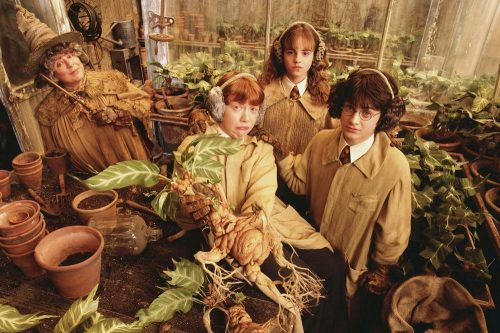



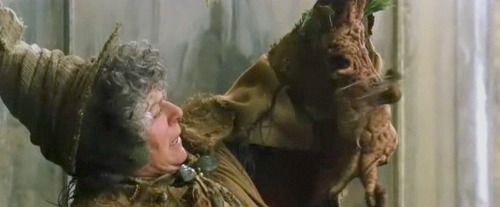
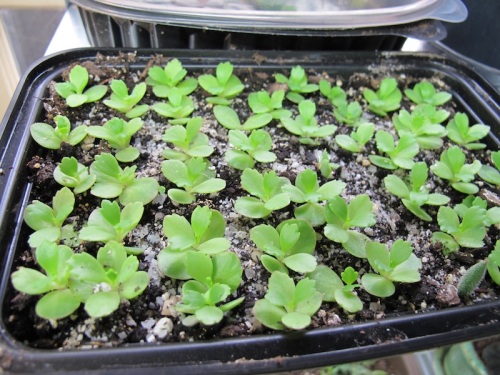
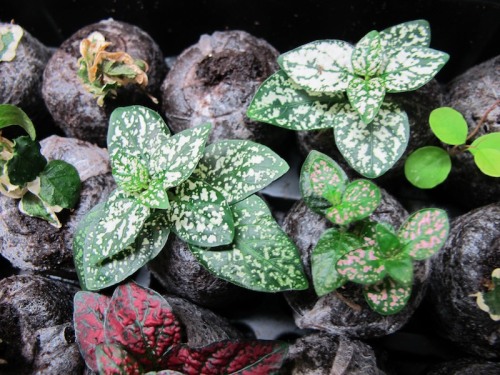


You must be logged in to post a comment.